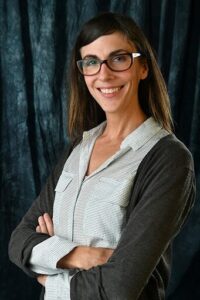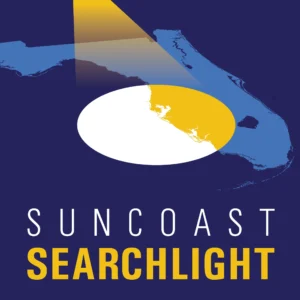The Suncoast Searchlight — the second iteration of the Barancik-funded idea — aims to be investigative.
Johannes Werner
Original Air Date: Jan. 24, 2025
Host: Version 2.0 for the Community News Collaborative is about to launch. After a one-year run in 2023-24, the funders last year shut down version 1.0 of the non-profit newsroom. Now they are relaunching it as Suncoast Searchlight, a more investigative version that—like its predecessor—will offer its stories to local news media, including WSLR News. Funded with a million dollars from the Barancik Foundation, the newsroom opening soon on North Lime Avenue near downtown Sarasota is a response to the growing news desert. We talked to Emily Le Coz, the just-hired executive editor of the Suncoast Searchlight.
Johannes Werner: Le Coz came back to Sarasota—following a stint as an investigative editor at USA Today’s headquarters—after a decade with the Herald-Tribune. As a reporter on the newspaper’s investigative team, she was one of the authors of the award-winning “Bias on the Bench” series.
Now, she wants to bring that investigative experience to the non-profit newsroom she’s heading. The Barancik Foundation’s investment is aiming at filling the void left by the shrinking business of legacy media.

Emily Le Coz.
Emily Le Coz: They clearly saw a need to address the local impact of the nation’s rapidly shrinking news industry. I’ve seen it firsthand working in the news industry since the late ‘90s, and certainly, in the last 5-10 years, we’ve really witnessed dwindling resources at our legacy media companies. The Sarasota Herald-Tribune, for example, used to have a robust investigations team and a robust newsroom in general. We had our own huge, beautiful building on Main Street with dozens and dozens and dozens of reporters. Today, it is operating out of the bank building next door, nowhere near as many reporters as they used to have. The reporters who they do have are amazing, but you can only cover so much ground with a handful of reporters, and so they are working tirelessly to provide as much news coverage as they can, but they’re so busy just doing the day-to-day work that they don’t always have time to do the deeper explanatory journalism, analysis journalism, and investigative journalism that they were known for. Certainly that’s the case not just at the Herald-Tribune, which of course I know more intimately because of my tenure there, but all over the place. So I know that the folks at the Barancik Foundation lamented the loss of robust news coverage and felt as though it was doing a disservice to our community by not having that coverage. The investment that they made to fund our newsroom really is an investment in the community.
JW: The non-profit’s name continues to be “Community News Collaborative,” but the business name—Suncoast Searchlight—is new, and it is meant to reflect the new approach. Le Coz has already hired two investigative reporters, and she’s in the process of hiring two more.
ELC: I’m hiring four reporters who are and will be watchdog and investigative reporters. All of them are coming with a background doing the type of journalism that this organization is tasked with doing, which is that deeper explanatory making-sense-of-the-news type of journalism.
JW: One of the hires is Josh Salman, who has covered real estate for the Herald-Tribune; the other one is a reporter with deep knowledge of data, coming from Washington DC.

Some of the obscure spots in local coverage Le Coz wants to light up are the storms and flooding.
ELC: Top of mind for me as a resident of this community for the past ten years, and certainly having been here this past hurricane season, is trying to make sense of the back-to-back hurricanes that we had, the immense flooding that we had in parts of our community that had never seen flooding before, and understanding, “Okay, how did we get here? Should we have seen this coming? What was done or what wasn’t done to prepare us for those back-to-back disasters? Where are we going from here?” All of those questions. There are probably dozens of deeply researched, well-told stories that should come from making sense of those disasters.
JW: Another one are policy decisions and new practices implemented by the Sarasota County Commission last year.
ELC: I’m thinking, for example, of some of the decisions that were made last year with regards to which charitable organizations to fund and some of the funding decisions that happened. I would have loved to see more analysis of the decision-making that went into those votes and the impact it had on those organizations that had been relying on and counting on that funding.
JW: The office on North Lime is not in a high-visibility spot. But, as opposed to the previous newsroom, which was located on the campus of USF Sarasota-Manatee, it’s embedded in a fast-changing neighborhood near downtown, and it will offer a community room for public and events and journalism training.
Le Coz says she hopes the first stories will be coming within two to three weeks.
Reporting about reporters, this is Johannes Werner for WSLR News.
WSLR News aims to keep the local community informed with our 1/2 hour local news show, quarterly newspaper and social media feeds. The local news broadcast airs on Wednesdays and Fridays at 6pm.